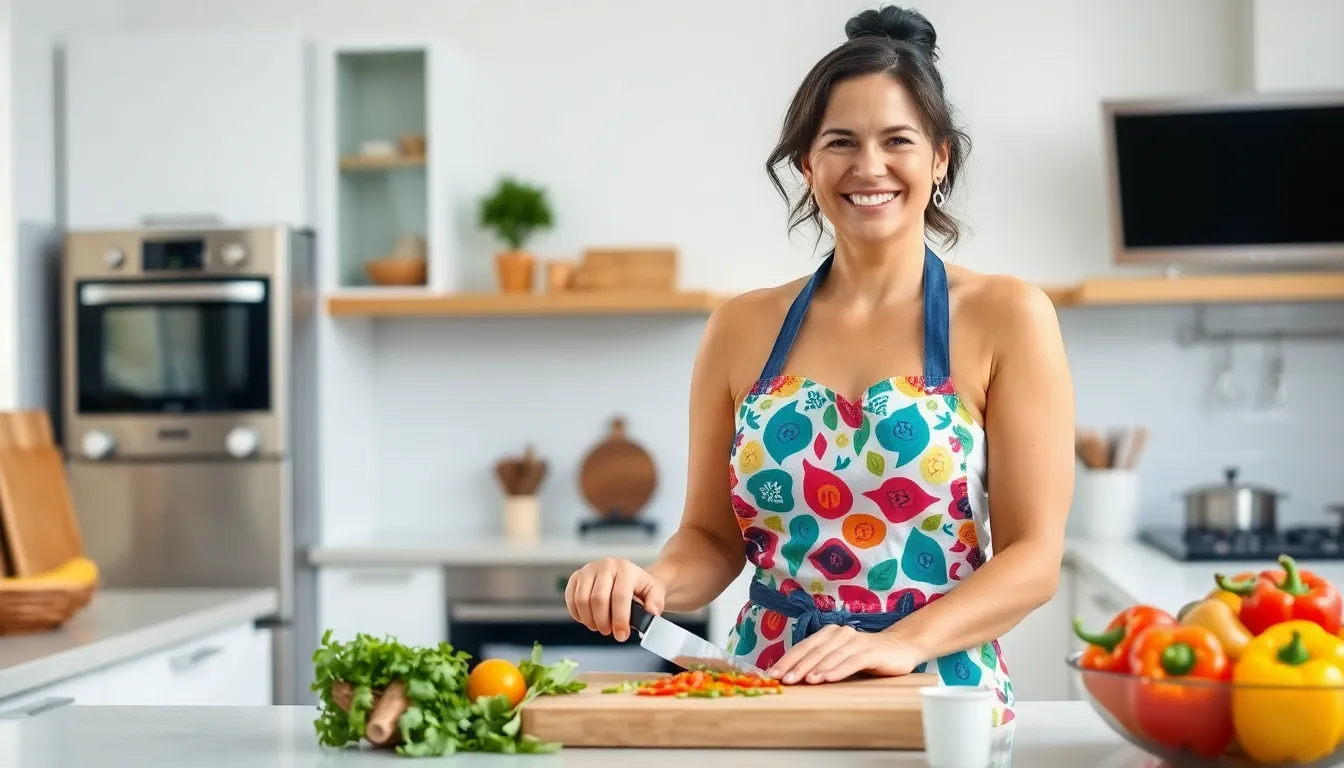In the culinary world, mastering basic cooking techniques is like having a superpower. Whether it’s sautéing like a pro or boiling water without setting off the smoke alarm, these skills can transform anyone from a kitchen novice to a culinary hero. Imagine impressing friends with a perfectly seared steak or whipping up a creamy risotto that would make even Gordon Ramsay nod in approval.
Table of Contents
ToggleUnderstanding Basic Cooking Techniques
Mastering basic cooking techniques boosts culinary skills and builds confidence. Sautéing involves cooking food quickly in a small amount of fat over high heat. Whether preparing vegetables or proteins, this technique locks in flavor and moisture.
Boiling water stands as one of the simplest techniques. It serves as a foundation for cooking pasta, grains, and vegetables. Consistent boiling ensures even cooking and proper texture.
Another essential technique is baking, which uses dry heat in an oven. This method transforms ingredients into delectable dishes like cakes, cookies, and bread. Precise measurements and timing are crucial for success.
Steaming offers a healthy alternative, preserving nutrients and flavor. Using steam helps maintain the vibrant colors of vegetables while ensuring tenderness. This technique also applies to fish and grains.
Roasting enhances the flavors of meats and vegetables through dry heat. Caramelization creates rich flavors and textures. It involves high temperatures and a significant amount of time, allowing natural sugars to develop.
Grilling adds a unique char and smoky flavor to proteins and vegetables. Direct heat allows for quick cooking and exciting textural contrasts. Techniques vary from using gas grills to charcoal, each offering different taste profiles.
Frying, on the other hand, involves cooking food in hot oil, creating a crispy exterior. Deep frying and pan frying offer varying results, with deep frying completely submerged and pan frying using just enough oil to coat the surface.
Understanding these basic techniques lays the groundwork for more advanced cooking skills. Each method has distinct purposes and variations, enabling flexibility in various recipes.
Essential Cooking Methods

Mastering essential cooking methods significantly enhances culinary skills. These techniques provide a strong foundation for creating a variety of dishes.
Boiling and Simmering
Boiling involves rapidly cooking food in water at 212°F (100°C). This technique works well for pasta and vegetables, as it ensures even cooking. Simmering, on the other hand, occurs at lower temperatures, around 180°F to 205°F (82°C to 96°C). It allows flavors to develop without overcooking ingredients. Both methods require careful attention to time and temperature for optimal texture.
Baking and Roasting
Baking requires dry heat in an oven, making it essential for pastries, breads, and casseroles. Accurate measurements are vital for successful outcomes. Roasting utilizes high temperatures, often between 400°F and 450°F (204°C to 232°C), to caramelize and enhance flavors in meats and vegetables. Timing is critical; overdoing it can lead to dryness while undercooking may result in unsafe dishes.
Sautéing and Stir-Frying
Sautéing cooks food quickly in a small amount of fat, typically over medium to high heat. This technique retains moisture and flavor. Alternatively, stir-frying focuses on cooking food rapidly in a wok, often requiring constant movement. Both methods emphasize the importance of cut uniformity for consistent cooking and even flavor distribution.
Grilling and Broiling
Grilling imparts a unique smoky flavor to meats and vegetables, often achieved over direct heat. Numerous methods exist, including gas, charcoal, and electric grilling. Broiling, in contrast, cooks food with high heat from above, typically in an oven. This technique is perfect for thinner cuts of meat, as well as melting cheese or browning dishes. Timing and distance from heat sources determine the final results.
Preparing Ingredients
Preparing ingredients forms the backbone of successful cooking. Mastering techniques like chopping and marinating sets the stage for flavorful dishes.
Chopping and Slicing
Chopping involves cutting ingredients into small, uniform pieces. This method ensures even cooking and helps flavors blend effectively. Slicing, on the other hand, focuses on creating thin, flat pieces, ideal for items like vegetables or meats. Proper knife skills enhance safety and efficiency in the kitchen. Using a sharp knife promotes accuracy and ease when cutting. Different terrains of cutting boards, whether wooden or plastic, affect the freshness and longevity of knife edges. Always maintain a stable cutting surface for consistent results in preparation. Paying attention to ingredients’ sizes allows for uniform cooking and presentation.
Marinating and Seasoning
Marinating introduces flavor, moisture, and tenderness to proteins and vegetables. A basic marinade combines acidic components like vinegar or citrus with oil and seasonings. The process typically lasts anywhere from 30 minutes to overnight, depending on the ingredient and desired flavor intensity. On the other hand, seasoning adds immediate flavor to dishes. Herbs, spices, and salt are easily adjusted to personal taste. Each seasoning contributes unique characteristics, enhancing overall taste. It’s important to taste dishes during cooking to determine additional seasoning requirements. Understanding the balance between saltiness and acidity creates depth in flavor profiles. Keeping a range of seasonings on hand accommodates diverse cooking styles and preferences.
Safety and Hygiene in Cooking
Maintaining safety and hygiene during cooking is crucial for preventing foodborne illnesses. Always start with clean hands; washing them with soap and water for at least 20 seconds reduces the risk of contamination. Using separate cutting boards for raw meat and vegetables also prevents cross-contamination, ensuring food safety.
Proper storage of ingredients is essential. Refrigerating perishables promptly keeps food fresh and reduces bacterial growth. The fridge temperature should remain below 40°F (4°C) to preserve food quality. Checking expiration dates on products ensures that no spoiled items enter the meal preparation process.
Additionally, using clean kitchen tools is vital. Regularly sanitizing utensils, pots, and pans helps eliminate harmful bacteria. When preparing food, wiping down surfaces with a sanitizing solution minimizes the risk of cross-contamination. Following these practices fosters a safer cooking environment.
Knowing the correct temperatures for cooking various foods is also important. For example, poultry should reach an internal temperature of 165°F (74°C) to ensure it is fully cooked. Measuring temperatures with a food thermometer accurately assesses doneness and contributes to food safety.
Paying attention to personal hygiene remains a key component. Wearing clean clothes and tying back hair helps maintain cleanliness in the kitchen. If cuts or wounds exist, covering them with a waterproof bandage protects food from potential contamination.
Lastly, being aware of the “danger zone” for food temperatures enhances safety. This range, between 40°F (4°C) and 140°F (60°C), allows bacteria to grow rapidly. Keeping food outside this zone as much as possible helps keep meals safe and enjoyable.
Mastering basic cooking techniques opens the door to culinary creativity and confidence. These skills not only enhance the quality of dishes but also make cooking a more enjoyable experience. Whether it’s sautéing vegetables to perfection or baking a delicious cake, each technique contributes to a cook’s repertoire.
By understanding the fundamentals of ingredient preparation and kitchen safety, anyone can elevate their cooking game. Embracing these essential skills allows for experimentation and the ability to adapt recipes with ease. As one becomes more comfortable in the kitchen, the possibilities for creating delightful meals become endless.







